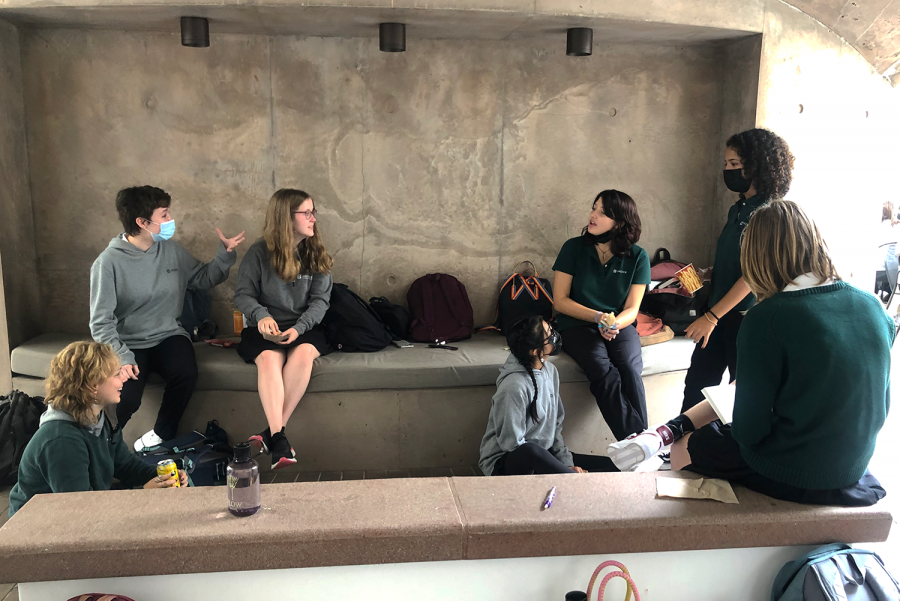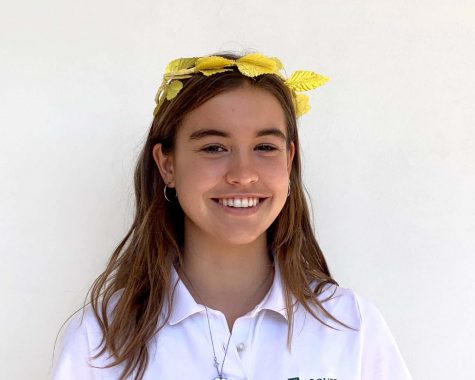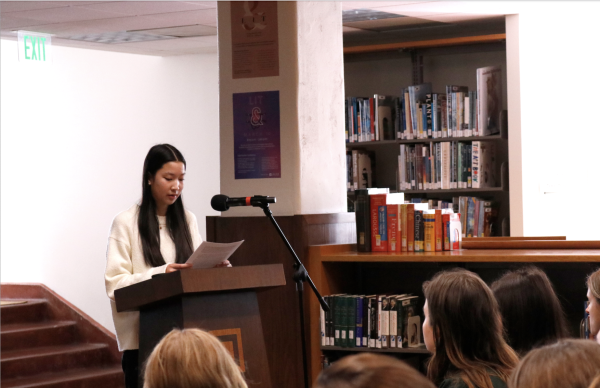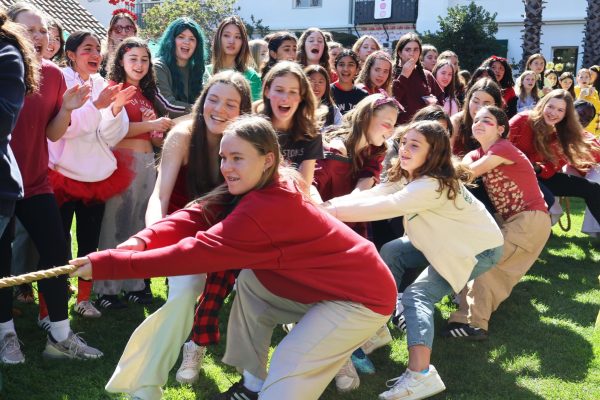Connection protection: New cell phone practices introduced to the upper school
Photo credit: Julissa Cach
A group of sophomore students converse at lunch during the first week of school. As new cell phone practices were introduced to the upper school during a virtual meeting, students look to engage with one another during free time while minimizing technology use.
September 7, 2021
In the age of electronics, access to screens is nearly endless: laptops are used at school, phones are in-hand during free time and, during the pandemic, all this was heightened as hours were spent on Zoom or Facetime with limited face-to face interaction. As students return to in-person school after over a year of virtual learning, school leaders look to limit student screen time and extend connection by implementing new cell phone practices in the upper school.
“We are trying to encourage everyone to come back and engage with one another — to have these connection protection times,” Dean of Student Life, Equity and Inclusion Samantha Hazell-O’Brien said. “For example, in the hallway when you’re walking with someone, instead of taking out your phone it’s a really better practice to talk to the person next to you.”
While the official cell phone policy as written in the handbook remains fundamentally unchanged in terms of limiting phone conversations to the front veranda and back field, allowing responsible and respectful phone use during free time and requiring students to turn phones off during classes, mentorship, meetings and assemblies, Hazell-O’Brien introduced new practices of engagement to the student body during a virtual upper school meeting on Wednesday.
I was a little shocked at first, but as the rules have been put into practice over the last few days, I’m actually really enjoying not using my devices as much.
— Amelia Hines
Hazell-O’Brien encouraged students to engage and build connections with one another by limiting use of technology, mainly cell phones, at times of peer interaction. This includes time between classes, such as while walking in the hallways, waiting at classrooms before class time and during US-FLX block, lunch and other free periods. For many upper school students who are accustomed to greater cell phone freedom, these practices initially came as a shock.
“It’s going to take a lot of time getting used to [the new practices] after Zoom and being on our devices all day last year,” sophomore Amelia Hines said. “It’s definitely going to be a trial period getting into this, but I’m really grateful that Archer is so intentional and they care enough to want us to connect with each other and have this opportunity. So maybe it’s a little inconvenient now, but I have hope that it’ll be a great addition to our culture.”
The lack of connection that occurred among students and faculty in the past year as a result of the pandemic drove the revision of cell phone practices in the upper school. The practice of using technology in a minimal way can help bolster previously-formed relationships as well as build new ones, Hazell-O’Brien said. She also noted an additional reason for the refashioned practices.
“We were hearing from incoming ninth graders asking what we do on-campus to connect with one another. We have different leadership opportunities and we have athletics, et cetera,” Hazell-O’Brien said. “But then we started thinking about where we normally engage in some conversation about subject matter — where those high touch points happen and they happen in between classes in the hallways — they happen when you’re waiting in line for the servery or when you’re out in the courtyard, so we are really trying to encourage people to look up and move around with hopes to build relationships.”
Some upper school students welcomed the announcement, while others were more apprehensive. For many students who had experienced fewer cell phone restrictions in the past at Archer, the implemented practices meant adjusting routines.
“There is both a good and a bad to it,” junior Alyssa Ponrartana said. “On one hand it’s good — in class, it makes sense to not use our phones, and it makes sense that we would want to be connecting socially after COVID but we’re born into a digital age — it’s what we know — a lot of us email on our phones or we organize our schedules on our phones, so it’s a lot more difficult to do things like that with the new practices. The intention is there. We want to connect but I think the practices could be more self directed.”
Although the school leaders put the new practices into action as soon as the school year commenced, Hazell-O’Brien said she is receptive to student feedback and opinion.
“With the senior class having had this experience with remote learning for quite a long time but now getting their senior year, I really want to hear from them what they think works well. I can only be in and around the classes some of the time so if they are telling me [they] have other opportunities to connect and have these relationships with one another, we’re open to that,” Hazell-O’Brien said. “Things are fluid to make sure that it’s best serving students. If we find that this is working, let’s take it and embrace it, and if it’s not working then we’ll tweak it to wherever serves us.”
It’s fair to say everything is a pilot program to figure out what is best.
— Samantha Hazell-O'Brien
As the upper school becomes accustomed to the new cell phone practices, Hines foresees a permanence to the reduced technology use.
“I do think it can really work its way into our culture. Archer is so intentional and friendly…so I think a lot of people will catch on in this time,” Hines said. “I hope that it does stick and become more permanent because I think that will be a great thing for our environment. I think it’s a very Archer thing.”
Looking forward, Hazell-O’Brien noted the importance of communicating with the upper school as well as faculty and staff in regards to the cell phone practices.
“Articulating the goals of the practices more is important, and that way all the students understand the messaging is to add, not subtract, and really point out that this is a small area when we’re inviting you to relate to one another,” Hazell-O’Brien said. “It will be helpful to reiterate that messaging but then modeling it ourselves. So, for example, when I’m walking through the hallways, I will be making sure I’m not on technology, and I know adults are just as active on their phones as students — so it’s the same messaging we’ve been sending to faculty and staff.”
As well as adults modeling behaviors for students, Hines believes upper schoolers must take on the responsibility of leading by example for the younger Archer students.
“We are the models for the middle school, and [the] middle schoolers aren’t allowed to have their phones at all,” Hines said. “I think if they see their Archer sisters limiting their screens, too, it will make us feel more connected with each other and bridge the gap between middle school and upper school.”





![Freshman Milan Earl and sophomore Lucy Kaplan sit with their grandparents at Archer’s annual Grandparents and Special Friends Day Friday, March 15. The event took place over three 75-minute sessions. “[I hope my grandparents] gain an understanding about what I do, Kaplan said, because I know they ask a lot of questions and can sort of see what I do in school and what the experience is like to be here.](https://archeroracle.org/wp-content/uploads/2024/03/grandparents-day-option-2-1200x800.jpg)
























































![Freshman Milan Earl and sophomore Lucy Kaplan sit with their grandparents at Archer’s annual Grandparents and Special Friends Day Friday, March 15. The event took place over three 75-minute sessions. “[I hope my grandparents] gain an understanding about what I do, Kaplan said, because I know they ask a lot of questions and can sort of see what I do in school and what the experience is like to be here.](https://archeroracle.org/wp-content/uploads/2024/03/grandparents-day-option-2-600x400.jpg)





Jennifer Dohr • Sep 8, 2021 at 9:59 am
Thank you, Greta. I’m already enjoying seeing more lifted faces and smiles (well, imagined smiles).